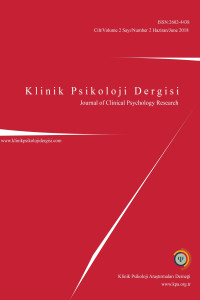Öz
İntihar davranışları tüm dünyada yaygın bir sorun olarak karşımıza çıkmaktadır. Sorunun bu denli yaygın olması, intihar riski taşıyan bireylerin belirlenmesini ve bu esnada kullanılacak olan yöntemleri önemli kılmaktadır. İlgili alanyazında, bu amaçla sıklıkla kullanılan ölçeklerden birinin İntihar Olasılığı Ölçeği (İOÖ) olduğu görülmektedir. Türkiye’de bu ölçek üzerinde iki farklı temel çalışmanın mevcut olduğu ve bu çalışmalar sonucunda iki farklı formunun bulunduğu ve kullanıldığı gözlenmektedir. Şahin ve Batıgün (2000), sınırlı bir örneklem ile gerçekleştirdikleri çalışmalarını rapor haline getirmiş ancak yayınlamamıştır. Ölçeğin kullanımları esnasında, ilk çalışmadaki faktör yapısının doğrulanamadığı gözlenmiş ve daha büyük ve farklı örneklemler ile tekrar çalışılma ihtiyacı doğmuştur. Buradan hareketle, mevcut çalışmanın amacı, ölçeğin Şahin ve Batıgün (2000) tarafından çalışılan formunun yapısını ve geçerlik ve güvenirlik bulgularını gözden geçirmektir. Çalışma, 301 ve 994 kişiden oluşan iki farklı örneklem grubu üzerinde yürütülmüş, ikinci örneklem yalnızca doğrulayıcı faktör analizi için kullanılmıştır. Yapılan açımlayıcı ve doğrulayıcı faktör analizleri sonucunda “Sosyal Destek/Benlik Algısı”, “Öfke/Dürtüsellik”, “Umutsuzluk/Yalnızlık” ve “İntihar Düşüncesi” olmak üzere dört faktör bulunmuştur. Doğrulayıcı faktör analizi sonuçları, model uyum indekslerinin kabul edilebilir sınırlar içerisinde bulunduğunu göstermektedir. Başka bir deyişle elde edilen yeni faktör yapısı doğrulanmıştır. Ayrıca ölçeğin güvenirliğine ilişkin elde edilen bulgular da tatmin edici değerlerdedir.
Anahtar Kelimeler
Öz
Suicide is a pervasive problem all around the world. Due to the pervasiveness of the problem, it is important to develop methods to detect suicidal people. When the related literature is investigated, Suicide Probability Scale is found to be one of the mostly used instruments. In Turkey, there are two independently conducted adaptation studies on this scale. The latter study by Şahin and Batıgün (2000), conducted with a small sample size, was not published at that time, but put into a report form. The other studies using the Şahin-Batıgün adaptation revealed that the factor structure found in the initial study was not confirmed, so that this created need for studying the factor structure on larger and different samples. Consequently, the aim of the current study was to investigate the factor structure and psychometric proper-ties of the Suicide Probability Scale, adapted by Şahin and Batıgün. The study was conduct-ed with two different samples; the first one included 301 and the second one included 994 participants, and the second sample was used only for confirmatory factor analysis. The exploratory and confirmatory factor analyses revealed a four-factor structure. The factors were named as: “Social Support/Self-Perception”, “Anger/Impulsivity”, “Hopelessness/Loneliness”, and “Suicidal Thoughts”. The results of the confirmatory factor analysis supported the four- factor structure with acceptable model fit indices. Other findings related to reliability and validity showed that Suicide Probability Scale is a reliable and valid instrument that can be used in both clinical applications and scientific researches in Turkey.
Anahtar Kelimeler
Ayrıntılar
| Birincil Dil | Türkçe |
|---|---|
| Konular | Klinik Psikoloji |
| Bölüm | Araştırma Makaleleri |
| Yazarlar | |
| Yayımlanma Tarihi | 25 Haziran 2018 |
| Gönderilme Tarihi | 26 Eylül 2017 |
| Yayımlandığı Sayı | Yıl 2018 Cilt: 2 Sayı: 2 |


